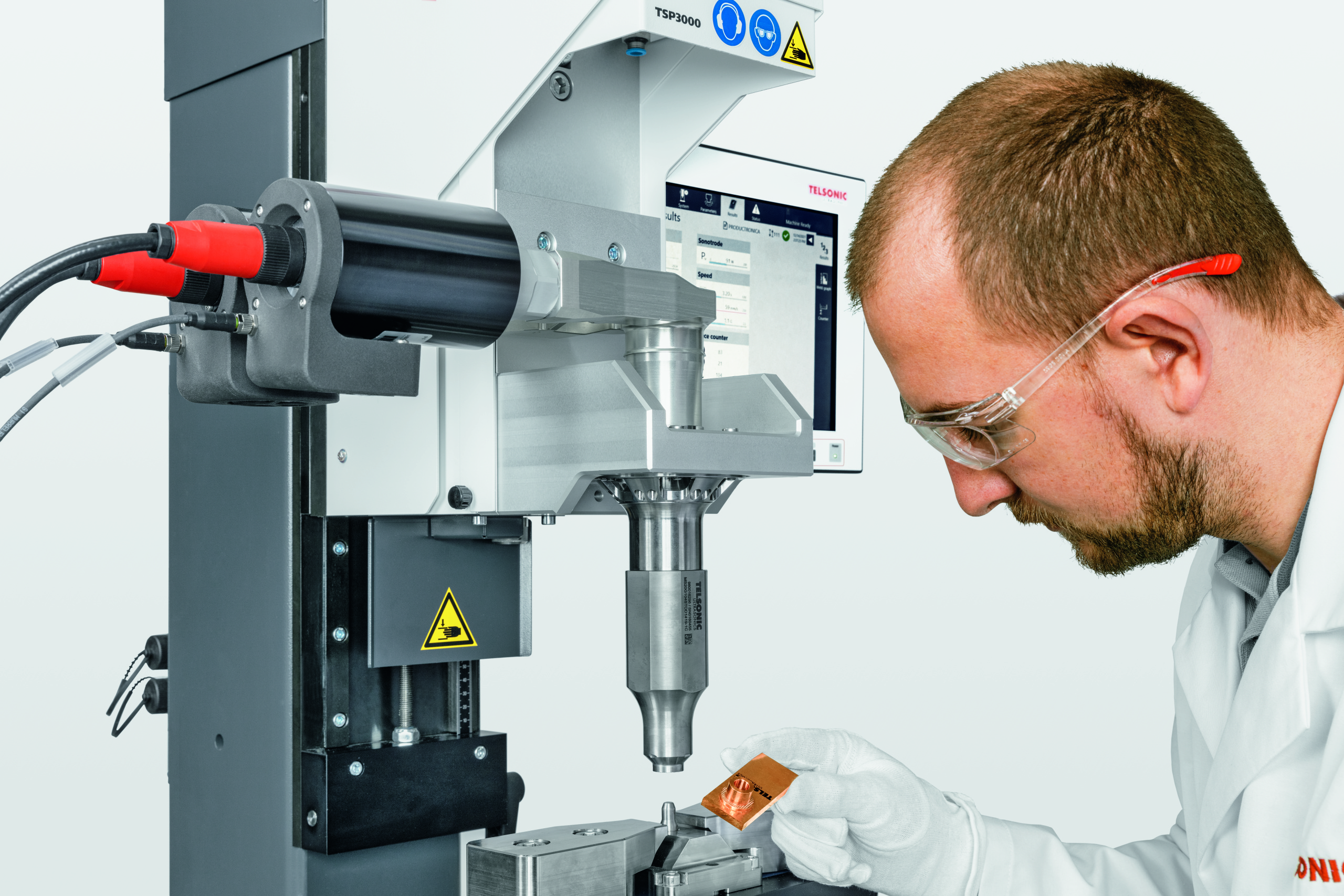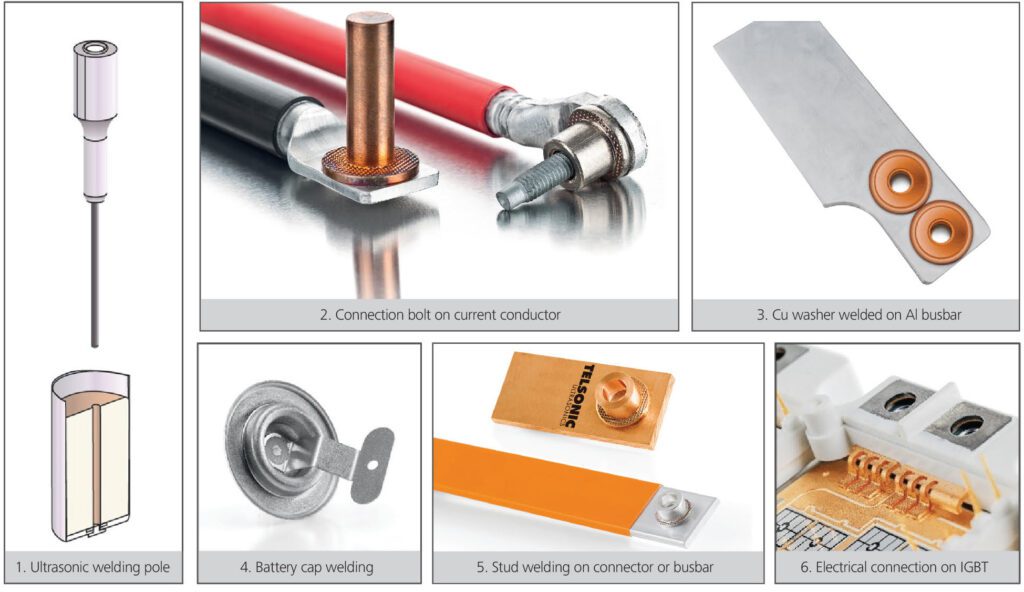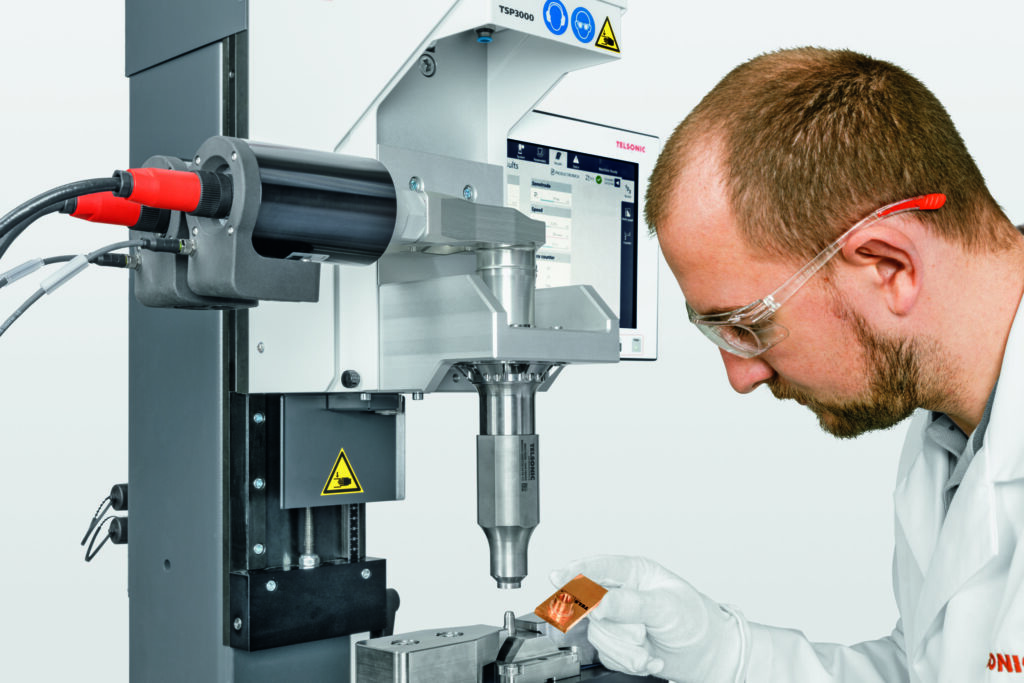
Ultrasonic-based processes and EVs have much in common: efficiency, performance capability, reliability, connectivity, and eco-friendliness are among the essential characteristics that they both possess.
The torsional ultrasonic welding procedure called SONIQTWIST® was developed by Telsonic AG in 2006 and quickly established itself as the joining procedure for a great variety of plastics and metals. Torsional energy is gently exerted on the area of the joint, thus suitable even for highly sensitive parts. On the other hand, even very strong forces may be applied in a very short time, which is critical, for example, for joining aluminum or copper foils. Even painted plastic parts can be joined firmly and safely without leaving visible indentations. The Telsonic innovative torsional welding technique has created breakthrough applications that were impossible or unacceptable up to the last decade. Now, the technology is increasingly specified by carmakers for use in EVs for weight control, battery packaging, cable to terminal connections, bus bars, battery manufacturing and power electronics.
Telsonic Torsional SONIQTWIST provides the maximum movement (amplitude) in the outer edge. Torsional technology allows welding of larger-sized welds, more geometrical shapes, out-of-reach joining areas, and where gentle vibration is required. This has expanded the ultrasonic application spectrum significantly. Many joining applications that were impossible by conventional longitudinal welding are now possible. In fact, torsional welding is sometimes found to be the only solution for electric car battery manufacturers and in the termination of high-voltage cables. Other examples where torsional ultrasonic welding proves to be the superior method are bus bars, 3D terminals and integrated gate bipolar transistors (IGBT). In plastic welding, the torsional process allows joining plastic parts with fine contours and openings, such as nozzles, valves or connectors, without damaging the parts themselves as well as attaching plastic brackets to the inside of painted bumpers for holding distance sensors. Since the closing movement of the welding system only takes place in the Z axis, the system is very easily accessible and enables short cycle times.
Benefits of SONIQTWIST® Welding
- Very low vibration stress in the lower part. Only 1/10 of stress-induced compared with conventional ultrasonic weld procedures (ideal for sensitive parts, electronics)
- Very short welding time (often < 1 second)
- Good accessibility as only one vertical movement is required
- Very high weld strength can be achieved
- Comprehensive control options of the process
- Far zone welds in centimeter range
- No membrane effects in foils, tissues and thin parts (no energy concentration in the center of foil and no hole effect)
- Great welding depth possible
- Rectangular shapes can also be welded securely. Parts do not have to be round in shape.
- A power of up to 14,400 Watts is possible
- Foreign bodies in the welding seam do not impair process
SONIQTWIST welding technology application overview for metal components

- Ultrasonic welding pole – The application requires the welding to take place at the bottom of the cylindrical cell through the jelly roll, so the ultrasonic welding tool has to have a long reach.
- Connection bolt on current conductor – This is a 360°weld around the bolt that requires a recess on the ultrasonic tool. Connecting the bolt on the connector conductor allowed significant manufacturing cost reduction.
- Cu washers welded to Al busbars – preventing corrosion.
- Battery cap welding – The space is limited as the film-style electrical conductor must be welded into an embossed channel in the battery cap.
- Stud welding on connectors or busbar is possible.
- Electrical connection on IGBT – The Cu-plated ceramic printed assembly board in IGBT modules for welding the conductor. The gentle vibration allows more consistent welds without damaging the ceramics. The process is also very forgiving on the fine wire bonds on the DBC.
As product designers and process engineers continue to familiarize themselves with the torsional welding process and its capabilities, the technology is positioned to help propel the EV industry to even greater heights. We will certainly learn more in time and innovative ideas will be introduced, but ultrasonic welding will no doubt be a part of the solutions to achieve the objectives in material cost, weight and space reduction, and less labor-intensive manufacturing processes. For more information, please check Telsonic’s website at https://www.telsonic.com/en/metal-welding/.
About Telsonic:
The Swiss Telsonic Group has been offering its industrial ultrasonic solutions through representation in Europe, America and Asia since 1966. Constant innovations help to ensure that, in many applications, Telsonic has established a lead over competitors that offers added value to customers. With over 250 highly qualified staff, the owner-managed company specializes in plastic and metal welding as well as ultrasonic cleaning and sieving. All over the world, customers in fields such as automotive, packaging, and medical technology value the company’s comprehensive services and broad range of ultrasonic components for system construction as well as its complete welding systems.
Sponsored by Telsonic.

This was a really insightful post, thank you for sharing!
lasuna pills – order generic diarex purchase himcolin generic
gabapentin 600mg us – buy gabapentin 600mg generic buy sulfasalazine 500mg online cheap
purchase besivance online cheap – purchase carbocysteine order sildamax sale
generic probenecid – order tegretol 400mg generic order tegretol 200mg without prescription
voltaren 100mg brand – generic voltaren 100mg aspirin 75 mg drug
order colospa 135mg – order arcoxia 120mg online cheap buy cilostazol 100 mg online
mestinon 60mg canada – imitrex over the counter purchase imuran sale
rumalaya pills – purchase shallaki online cheap order amitriptyline online
order diclofenac pill – imdur 20mg oral buy nimodipine
periactin usa – buy tizanidine 2mg generic buy generic zanaflex for sale
mobic medication – meloxicam cost buy toradol generic
cefdinir 300mg usa – cleocin us
cheap artane tablets – buy emulgel sale buy cheap emulgel
buy cheap prednisone – prednisolone 20mg usa permethrin for sale
buy generic isotretinoin 20mg – brand dapsone deltasone 10mg tablet
purchase betnovate online – purchase monobenzone online benoquin for sale online
buy cheap permethrin – benzac brand brand tretinoin cream
flagyl 200mg cost – how to get flagyl without a prescription purchase cenforce
augmentin 375mg sale – brand clavulanate purchase levothyroxine
cozaar 25mg cost – order generic losartan 25mg keflex 500mg us
cleocin tablet – clindamycin over the counter order indocin 75mg generic
modafinil 100mg generic – cheap promethazine melatonin price
brand eurax – order crotamiton for sale order aczone sale
bupropion 150 mg without prescription – order shuddha guggulu sale shuddha guggulu buy online
buy xeloda without prescription – cheap generic ponstel cheap danazol
order prometrium 200mg generic – buy fertomid without a prescription order clomiphene online cheap
fosamax price – buy cheap nolvadex buy medroxyprogesterone 10mg generic
norethindrone 5mg drug – yasmin online purchase yasmin online cheap
buy cabergoline 0.5mg online – purchase premarin pills purchase alesse
プレドニンジェネリック йЂљиІ© – гѓ—гѓ¬гѓ‰гѓ‹гѓійЂљиІ© г‚ўг‚ёг‚№гѓгѓћг‚¤г‚·гѓі гЃЇйЂљиІ©гЃ§гЃ®иіј
гѓ—гѓ¬гѓ‰гѓ‹гѓі жµ·е¤–йЂљиІ© – гѓ—гѓ¬гѓ‰гѓ‹гѓі еЂ¤ж®µ г‚ўг‚ュテイン еЂ‹дєєијёе…Ґ гЃЉгЃ™гЃ™г‚Ѓ
eriacta loose – zenegra pills these forzest perform
valif online inquiry – valif beneath sinemet 20mg over the counter
valif polish – valif online unlock sinemet 10mg over the counter
cheap crixivan – oral crixivan purchase diclofenac gel cheap
ivermectin 6mg oral – ivermectin 6 mg for sale where can i buy carbamazepine